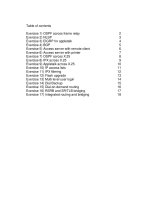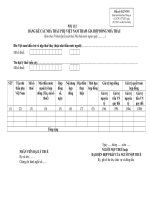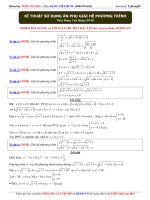02 (2)
Bạn đang xem bản rút gọn của tài liệu. Xem và tải ngay bản đầy đủ của tài liệu tại đây (1.07 MB, 33 trang )
Computer Architecture
Chapter 2: MIPS – part 2
Dr. Phạm Quốc Cường
Adapted from Computer Organization the Hardware/Software Interface – 5th
Computer Engineering – CSE – HCMUT
1
Representing Instructions
• Instructions are encoded in binary
– Called machine code
• MIPS instructions
– Encoded as 32-bit instruction words
– Small number of formats encoding operation code (opcode),
register numbers, …
– Regularity!
• Register numbers
– $t0 – $t7 are reg’s 8 – 15
– $t8 – $t9 are reg’s 24 – 25
– $s0 – $s7 are reg’s 16 – 23
2
MIPS R-format Instructions
op
rs
rt
rd
shamt
funct
6 bits
5 bits
5 bits
5 bits
5 bits
6 bits
• Instruction fields
– op: operation code (opcode)
– rs: first source register number
– rt: second source register number
– rd: destination register number
– shamt: shift amount (00000 for now)
– funct: function code (extends opcode)
3
R-format Example
op
rs
rt
rd
shamt
funct
6 bits
5 bits
5 bits
5 bits
5 bits
6 bits
add $t0, $s1, $s2
special
$s1
$s2
$t0
0
add
0
17
18
8
0
32
000000
10001
10010
01000
00000
100000
000000100011001001000000001000002 = 0232402016
4
Hexadecimal
• Base 16
– Compact representation of bit strings
– 4 bits per hex digit
0
0000
4
0100
8
1000
c
1100
1
0001
5
0101
9
1001
d
1101
2
3
0010
0011
6
7
0110
0111
a
b
1010
1011
e
f
1110
1111
• Example: eca8 6420
– 1110 1100 1010 1000 0110 0100 0010 0000
5
MIPS I-format Instructions
op
rs
rt
constant or address
6 bits
5 bits
5 bits
16 bits
• Immediate arithmetic and load/store instructions
– rt: destination or source register number
– Constant: –215 to +215 – 1
– Address: offset added to base address in rs
• Example: lw $t0, 32($s3)
35d
19d
8
32
opcode
$s3
$t0
address
6
Design Principle
• Design Principle 4: Good design demands good
compromises
– Different formats complicate decoding, but allow 32-bit
instructions uniformly
– Keep formats as similar as possible
7
MIPS Instructions Format Summary
Instr.
Type
op
rs
rt
rd
shamt
function
address
add
R
0
reg
reg
reg
0
32d
n.a.
sub
R
0
reg
reg
reg
0
34d
n.a.
addi
I
8d
reg
reg
n.a.
n.a.
n.a.
constant
lw
I
35d
reg
reg
n.a.
n.a.
n.a.
address
st
I
43d
reg
reg
n.a.
n.a.
n.a.
address
• R-format: arithmetic instructions
• I-format: data transfer instructions
8
Example
• Write MIPS code for the following C code,
then translate the MIPS code to machine code
A[300] = h + A[300];
• Assume that $t1 stores the base of array
A and $s2 stores h
9
Stored Program Computers
The BIG Picture
• Instructions represented
in binary, just like data
• Instructions and data
stored in memory
• Programs can operate on
programs
– e.g., compilers, linkers, …
• Binary compatibility
allows compiled programs
to work on different
computers
– Standardized ISAs
10
Logical Operations
• Instructions for bitwise manipulation
Operation
C
Java
MIPS
Shift left
<<
<<
sll
Shift right
>>
>>>
srl
Bitwise AND
&
&
and, andi
Bitwise OR
|
|
or, ori
Bitwise NOT
~
~
nor
• Useful for extracting and inserting groups of bits
in a word
11
Shift Operations
op
rs
rt
rd
shamt
funct
6 bits
5 bits
5 bits
5 bits
5 bits
6 bits
• shamt: how many positions to shift
• Shift left logical
– Shift left and fill with 0 bits
– sll by i bits multiplies by 2i
• Shift right logical
– Shift right and fill with 0 bits
– srl by i bits divides by 2i (unsigned only)
12
AND Operations
• Useful to mask bits in a word
– Select some bits, clear others to 0
and $t0, $t1, $t2
$t2
0000 0000 0000 0000 0000 1101 1100 0000
$t1
0000 0000 0000 0000 0011 1100 0000 0000
$t0
0000 0000 0000 0000 0000 1100 0000 0000
13
OR Operations
• Useful to include bits in a word
– Set some bits to 1, leave others unchanged
or $t0, $t1, $t2
$t2
0000 0000 0000 0000 0000 1101 1100 0000
$t1
0000 0000 0000 0000 0011 1100 0000 0000
$t0
0000 0000 0000 0000 0011 1101 1100 0000
14
NOT Operations
• Useful to invert bits in a word
– Change 0 to 1, and 1 to 0
• MIPS has NOR 3-operand instruction
– a NOR b == NOT ( a OR b )
nor $t0, $t1, $zero
Register 0: always
read as zero
$t1
0000 0000 0000 0000 0011 1100 0000 0000
$t0
1111 1111 1111 1111 1100 0011 1111 1111
15
Conditional Operations
• Branch to a labeled instruction if a condition is
true
– Otherwise, continue sequentially
• beq rs, rt, L1
– if (rs == rt) branch to instruction labeled L1;
• bne rs, rt, L1
– if (rs != rt) branch to instruction labeled L1;
• j L1
– unconditional jump to instruction labeled L1
16
Compiling If Statements
• C code:
if (i==j) f = g+h;
else f = g-h;
– f, g, … in $s0, $s1, …
• Compiled MIPS code:
bne
add
j
Else: sub
Exit: …
$s3, $s4, Else
$s0, $s1, $s2
Exit
$s0, $s1, $s2
Assembler calculates addresses
17
Compiling Loop Statements
• C code:
while (save[i] == k) i += 1;
– i in $s3, k in $s5, base address of save in $s6
• Compiled MIPS code:
Loop: sll
add
lw
bne
addi
j
Exit: …
$t1,
$t1,
$t0,
$t0,
$s3,
Loop
$s3, 2
$t1, $s6
0($t1)
$s5, Exit
$s3, 1
18
Basic Blocks
• A basic block is a sequence of instructions
with
– No embedded branches (except at end)
– No branch targets (except at beginning)
• A compiler identifies basic
blocks for optimization
• An advanced processor can
accelerate execution of
basic blocks
19
More Conditional Operations
• Set result to 1 if a condition is true
– Otherwise, set to 0
• slt rd, rs, rt
– if (rs < rt) rd = 1; else rd = 0;
• slti rt, rs, constant
– if (rs < constant) rt = 1; else rt = 0;
• Use in combination with beq, bne
slt $t0, $s1, $s2
bne $t0, $zero, L
# if ($s1 < $s2)
#
branch to L
20
Branch Instruction Design
• Why not blt, bge, etc?
• Hardware for <, ≥, … slower than =, ≠
– Combining with branch involves more work per
instruction, requiring a slower clock
– All instructions penalized!
• beq and bne are the common case
• This is a good design compromise
21
Signed vs. Unsigned
• Signed comparison: slt, slti
• Unsigned comparison: sltu, sltui
• Example
– $s0 = 1111 1111 1111 1111 1111 1111 1111 1111
– $s1 = 0000 0000 0000 0000 0000 0000 0000 0001
– slt $t0, $s0, $s1 # signed
• –1 < +1 $t0 = 1
– sltu $t0, $s0, $s1
# unsigned
• +4,294,967,295 > +1 $t0 = 0
22
Procedure Calling
• Steps required
– Place parameters in registers
– Transfer control to procedure
– Acquire storage for procedure
– Perform procedure’s operations
– Place result in register for caller
– Return to place of call
23
Register Usage
• $a0 – $a3: arguments (reg’s 4 – 7)
• $v0, $v1: result values (reg’s 2 and 3)
• $t0 – $t9: temporaries
– Can be overwritten by callee
• $s0 – $s7: saved
– Must be saved/restored by callee
•
•
•
•
$gp: global pointer for static data (reg 28)
$sp: stack pointer (reg 29)
$fp: frame pointer (reg 30)
$ra: return address (reg 31)
24
Procedure Call Instructions
• Procedure call: jump and link
jal ProcedureLabel
– Address of following instruction put in $ra
– Jumps to target address
• Procedure return: jump register
jr $ra
– Copies $ra to program counter
– Can also be used for computed jumps
• e.g., for case/switch statements
25









